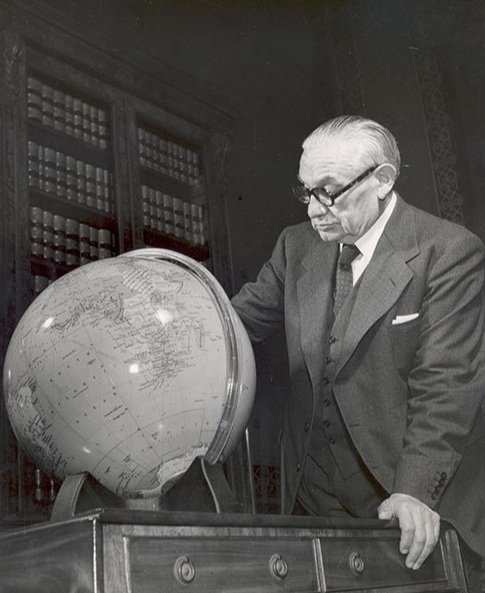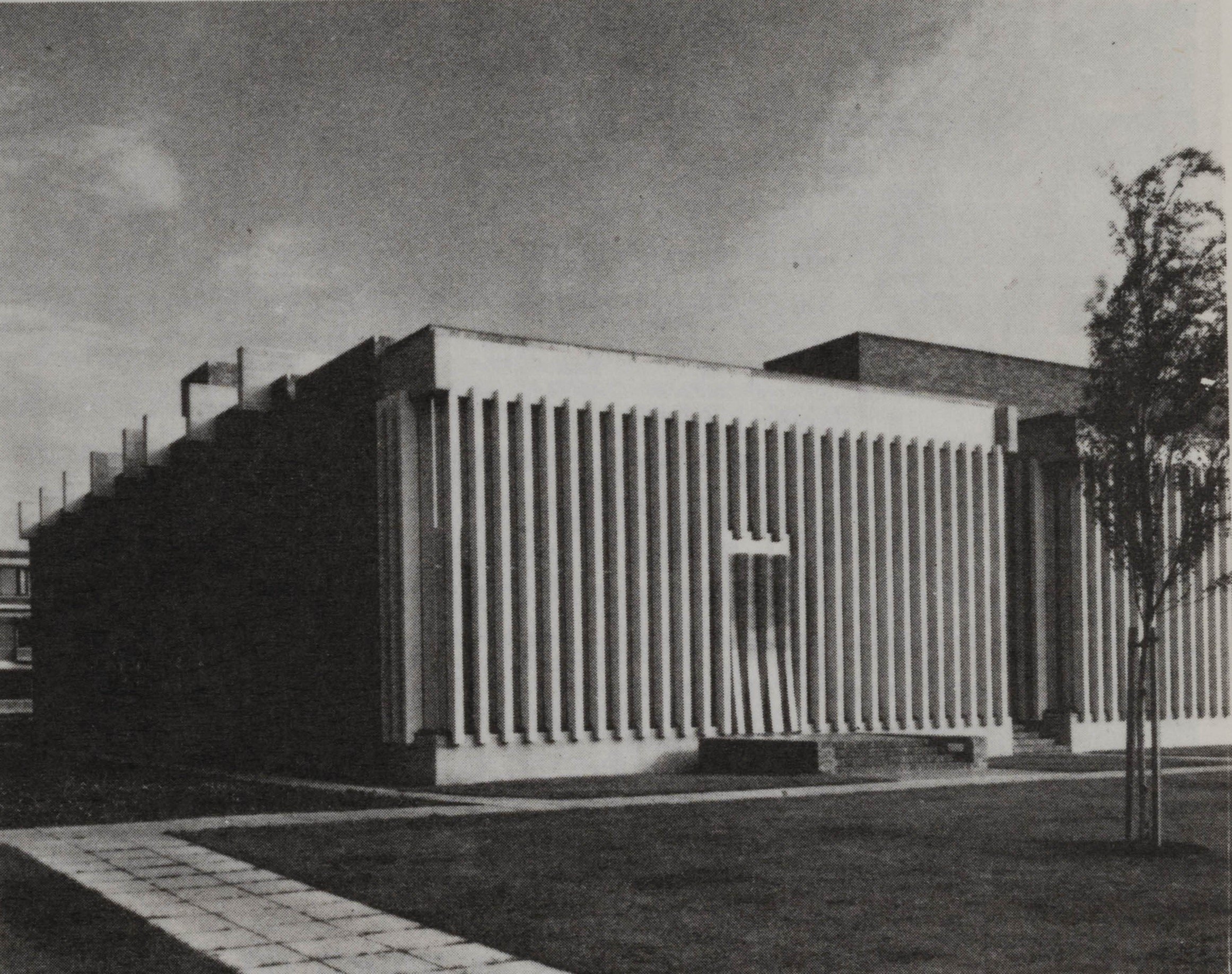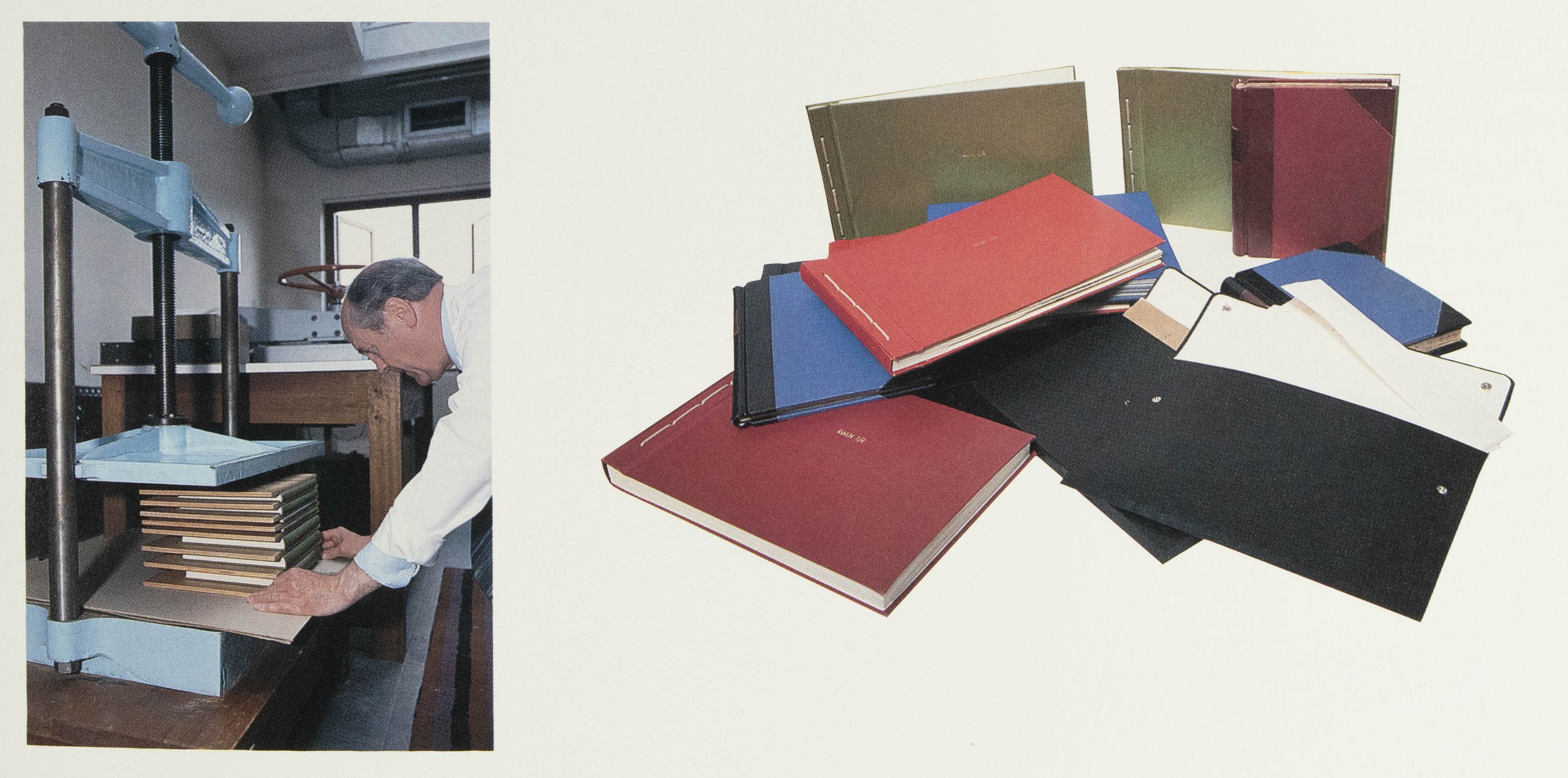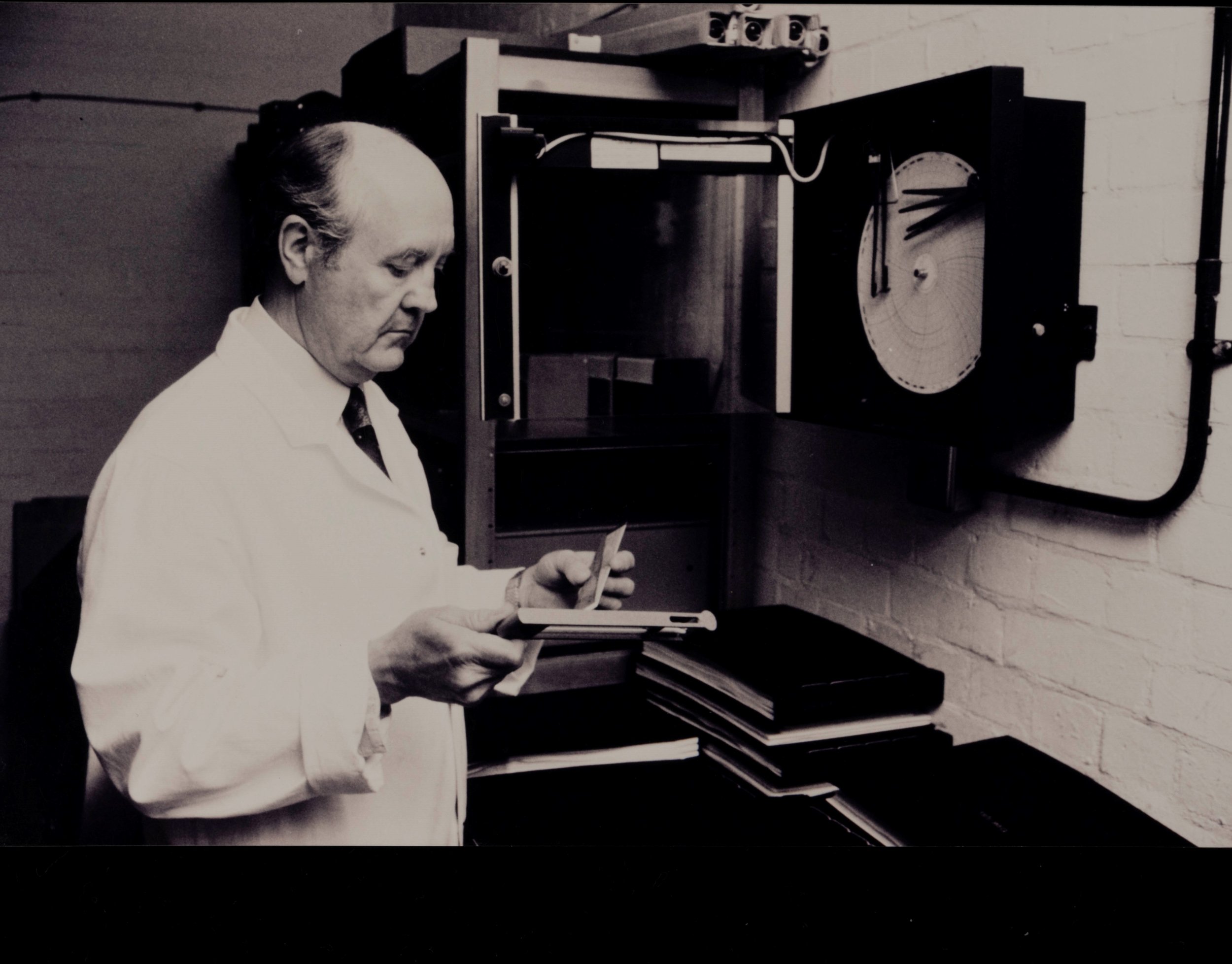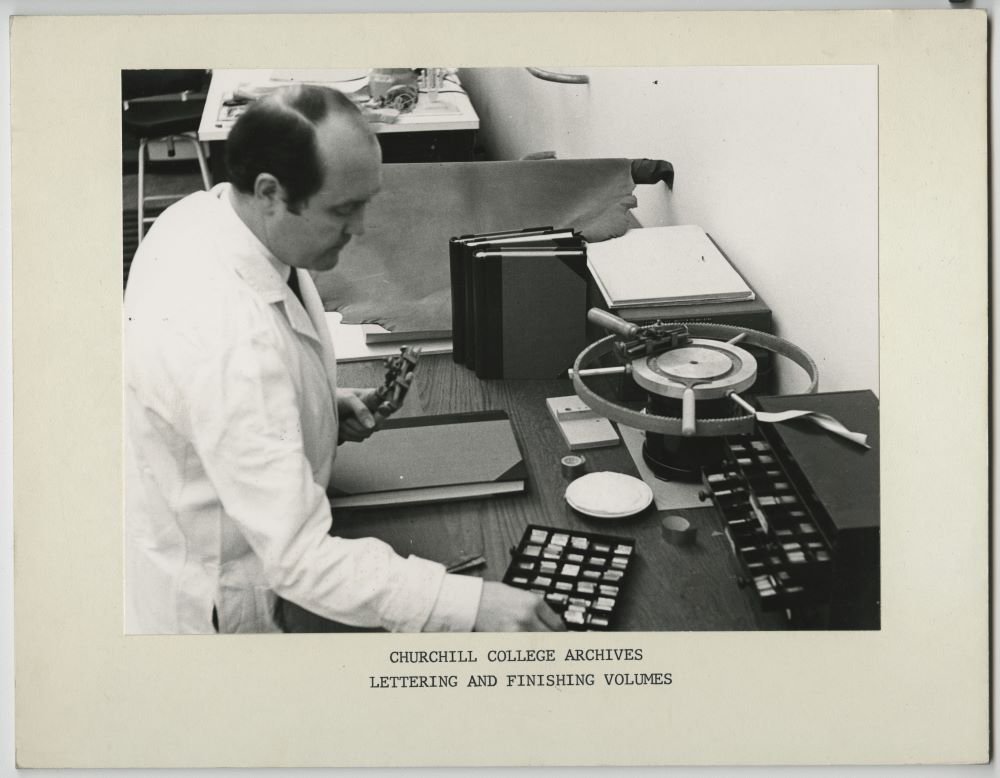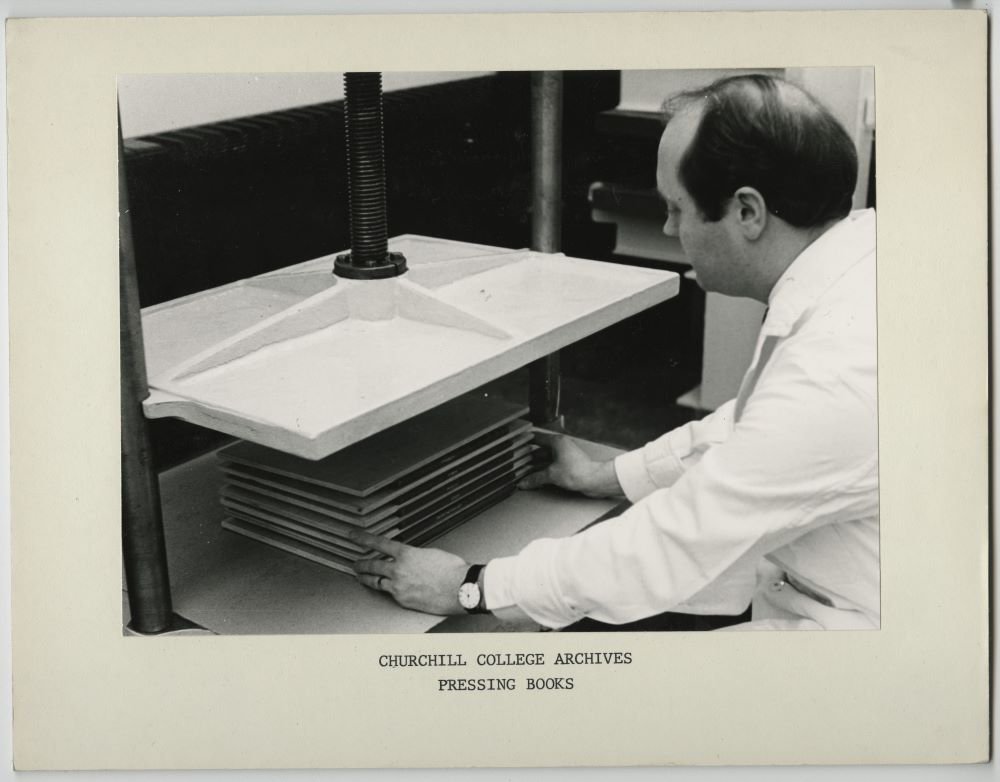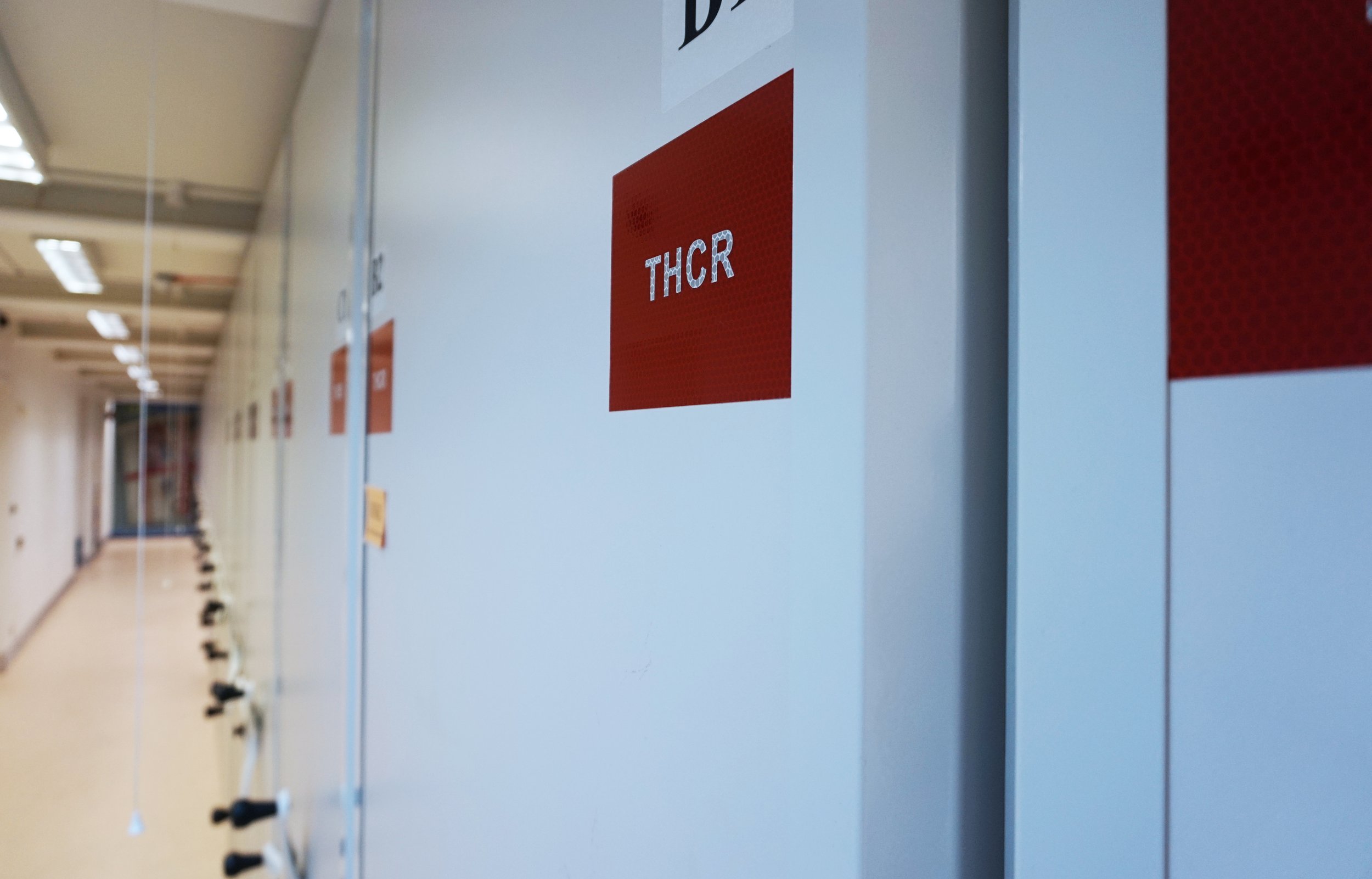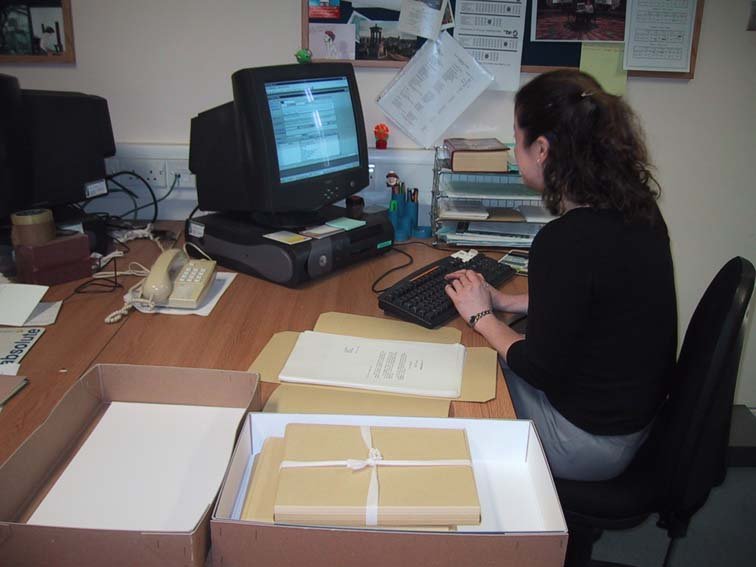
50 years of Churchill Archives Centre
In 2023, Churchill Archives Centre in Cambridge celebrated its 50th Anniversary.
In this online exhibition, we explore the people and events that have shaped our history.
1963: ‘I suppose the College does realise that Sir Winston’s papers are likely to come to it one day?’
When Churchill College was founded in 1960, it was built as the National and Commonwealth memorial to Sir Winston Churchill. The founders of this new Cambridge college envisioned it to be ‘a bridge between the achievements of the past and the possibilities of the future’. That being said, the idea of an archive, at heart of college, perhaps unsurprisingly wasn’t in the minds of the Founding Fellows
On a cold January evening in 1963, three years after the College was opened, it was in the college’s expansive dining hall that the seed for the Archives Centre was planted. Over a High Table dinner, Anthony Montague, Winston Churchill’s Private Secretary dropped an innocent question into a conversation with Senior Research Fellow, Captain Stephen Roskill, ‘I suppose the College does realise that Sir Winston’s papers are likely to come to it one day?’ The short answer was - no.
“I had a talk with several of our Senior Fellows about the possibility of the Churchill archives ultimately coming to this College. This was an entirely new idea to them, as it was to me. We all of us felt […] the suggestion was immensely attractive.”
Browne had clearly piqued Roskill’s enthusiasm for such a venture. In a letter to Roskill reflecting how the idea was ‘immensely attractive’. However, turning the idea of an archive into a reality was no easy task. Whose papers would it collect? Who would make the connections with potential depositors? And where would a physical archive fit on the existing College site? These were just some of the questions which needed to be answered over the next two decades.
In 1965, Roskill, joined by Sir John (“Jock”) Colville (former private secretary to Sir Winston and a trustee of the College), and Sir John Cockcroft (Nobel Prize-winning physicist and Churchill College Master), put their networks to good use. They sounded out whether their colleagues, prominent politicians, soldiers, and scientists, might have papers that they’d like to give to a brand new archives Centre. The answer was a resounding yes.
The Archive Centre’s first major accession was the papers of Lord Clement Attlee. Attlee’s papers were shortly followed by those belonging to Admiral De Robeck, politicians Ernest Bevin and AV Alexander, physicist Lise Meitner, Nobel prize-winning physiologist A V Hill, civil servant Maurice Hankey, Ernest Bevin, and courtier Lord Esher. In just a few years, Roskill, Colville, and Cockcroft had laid the foundations for a collecting policy which would leave a lasting legacy on the Archives Centre. By 1969, the Archives Centre had acquired over 100 accessions.
As the papers of prominent figures in modern British life began to arrive at Churchill College, the next challenge was where to store them. A book store behind the Bevin Library, complete with strong-room door, shelving and automated rolling shelving, seemed a good place for these first collections.
While visitors marveled at the boon of rolling shelving, researchers had very little space to consult the delights stored on the shelves. In some cases, the archival material had to be moved to a place where researchers could more easily study the papers. In this short video, Prof Gordon Martel remembers his first visit to Churchill to read the papers of Lord Esher.
1969: "I received a phone call […] inviting me to become Librarian with a view to constructing an Archives Centre.”
A new collection
While the papers of those relating to the Churchill-era began to fill the shelves of the library’s bookstore, none of Winston Churchill’s papers had graced the College’s grounds. Instead, they were poured over by Randolph Churchill and Martin Gilbert - Winston Churchill’s official biographers. As they began to wind up their research, it was Clementine Churchill who, in 1969, donated 80 boxes of her husband’s post-1945 collections to Churchill College.
A new Librarian
1969 was also the year that Michael Hoskin was recruited as the Librarian for Churchill College. After recognising the pace at which the Archive Centre was expanding, the Master tasked Hoskin, a historian of astrology, with the mission of constructing an Archive’s Centre. The material could no longer be contained in the Library’s book store. Hoskin felt it was vital for this new building to be at the heart of the College’s site. Hoskin worked closely with Sir Jock Colville to turn this vision into a reality. Colville played a particularly crucial role in acquiring the funding for such an endeavour.
[Colville took fund-raising in hand and had the bright idea of recruiting former American ambassadors to fund the building. The names of every ambassador from 1925 to 1973, and other wealthy Americans besides, today adorn the wall of the Jock Colville Hall.]
A new conservationist
It soon became clear that the College needed a Conservationist to care for the invaluable collections arriving in college. Vic Brown, arrived from Reading University Library Bindery to work as the college’s first Conservator. Here you can see him working in a large second floor room, which we still use today as the Conservation studio. Vic’s career was typical of those working in the conservation profession, which at that time, was a largely male-dominated occupation. Vic would remain at the College until XXX.
You can listen to an oral history interview with Vic on our Access Portal, where he reflects on his time working at the Archives.
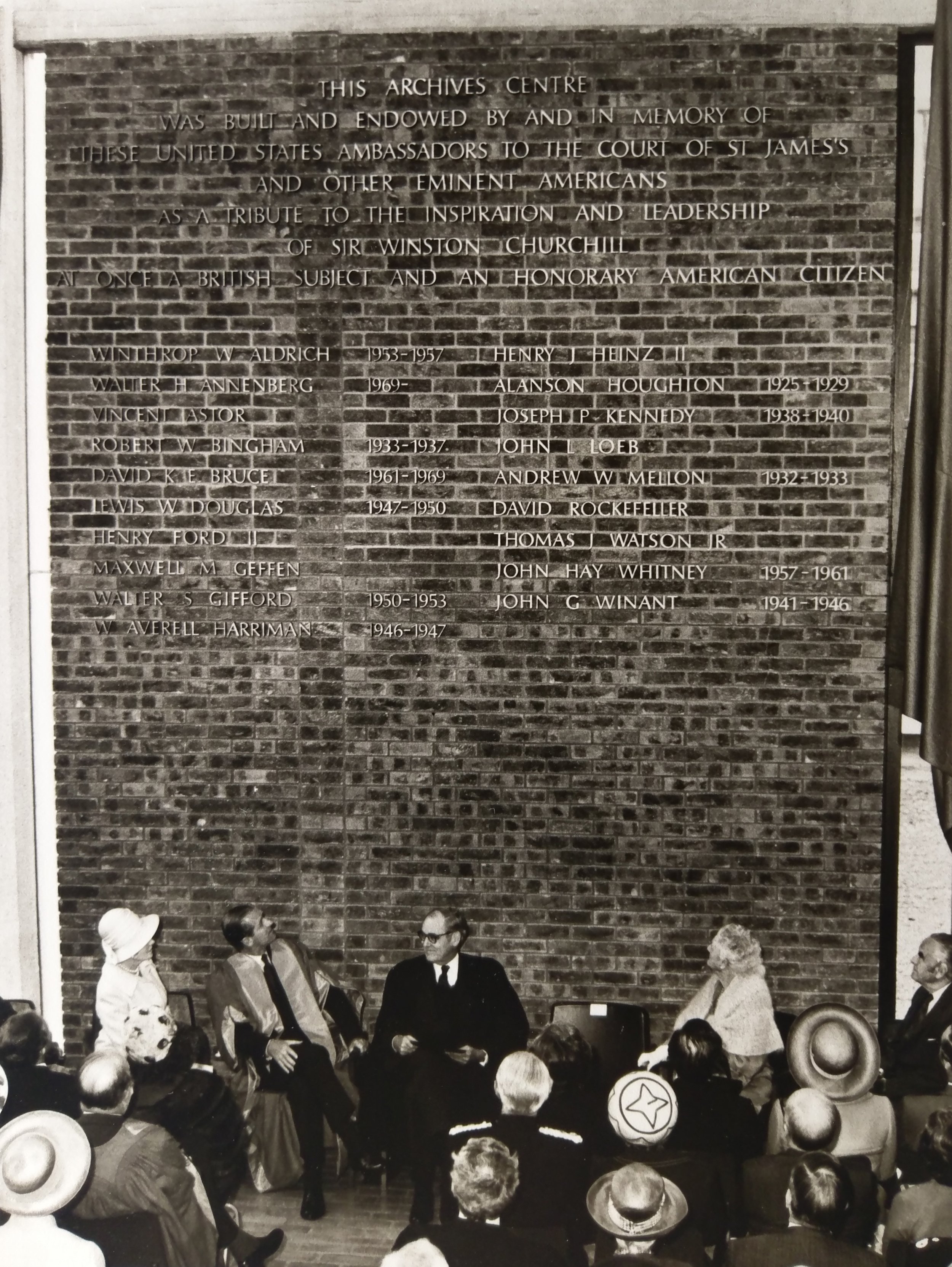
The Opening of Churchill Archives Centre
ADD CAPTIONS
[ADD DESCRIPTION OF NEW ARCHIVES CENTRE]
On 26 July, Churchill Archives Centre opened to a considerable fanfare - literally. Inside the brand new Archives Centre a trumpeter played XX from the gallery. As the music filled the newly-built hall, Walter H. Annenberg, the United States Ambassador, performed the opening in the presence of HRH Prince Philip and with Lady (Clementine) Churchill in attendance.
XX Michael Hoskin recalls how “It was a memorable day, not least because Mr Annenberg on arrival at the college eluded his secret service guards and presented himself to me at the Archives Centre itself, when he should have been in the party welcoming the Duke’s helicopter.”
“There was a very formal lunch at which the Master, who of course had to give the usual toasts, including on this occasion a toast to the President of the United States, because it was very much an American concern.”
A black and white film broadcast on local television to promote the opening of Churchill Archives Centre in July 1973.
Inside the Archives Centre
Reading Rooms
When it was opened in 1973, our reading room was initially made up of two air-conditioned rooms. One of the rooms was put aside for readers who were using typewriters and Dictaphones. Between them, the two rooms could host 20 researchers. The Reading Room also hosted the treasures of Stephen Roskill’s library and led to the naming of the Archive Centre’s book collection as the ‘Roskill Library’. The reading room also had a balcony, which overlooked the Exhibition Hall, which is now known as Jock Colville Hall. The balcony was removed in XX.
In 2019, we decided to make the Reading Room larger so that it could accommodate new readers. As we found fewer and fewer people made useof microfiche readers, we removed this room and created more desk pace, which is how you’ll find the Reading Room today.
[When was the Siebens Room named? Any photographs of the balcony? When removed?]

The Reading Room in 1978. Source: CAR/907/5
![Readers in our Reading Room in 1983. [?]
Source: CCAR/907/5](https://images.squarespace-cdn.com/content/v1/5f327a1eafa1f910a1b2baa9/4b02fdc2-9ab6-4d34-af8a-11dfcb1835a1/CCAR+907+5+pt+1+1983+to+1990+Reading+room.jpg)
Readers in our Reading Room in 1983. [?] Source: CCAR/907/5

Archive Assistant Pat Ackerman working at the desk in the main Reading Room in XX. Source: Pat Ackerman personal collection

Readers in our Reading Room c. 1980s, 1990s. This photograph was originally published in a promotional brochure titled 'Preserving To Preserve a Heritage of Greatness'. Source: CCAR/907/5

The microfiche room in our Reading Room in November 2019 before the refurbishment. Source: Refurbishment 2020, CCPH 5/8/4

The photograph of the main desk in our Reading Room, with the old microfiche room to the left, before the refurbishment in November 2019. Source: Refurbishment 2020, CCPH 5/8/4

Our Reading Room in March 2020 after the refurbishment. By removing the desk in our Reading Room, we made room for an additional workspace on our Front desk. Source: Refurbishment 2020, CCPH 5/8/4
Memories of the Reading Room
ADD TEXT HERE.
“Most of our readers are quite docile creatures, but there are occasional difficult characters in the search room area. You, which is underlined, are the person in charge and the archivist will back you up.”
“Here was a readily open, modern, efficient archive collection centre [...] Young scholars and PhDs could go in and be treated at the same level as a senior professor or a senior lecturer. It was a great way of saying that the study of history is egalitarian and should be.”
In order to access one of the 315 boxes, members of staff needed to operate our newly-built hydraulically powered shelves. In the short interview below, Clare Brown, the Archive Centre’s second Archives Assistant, remembers operating the shelves and the system which members of the Archive’s Team devised to ensure that no member of staff was caught between the stacks.
In1995, after decades of use, the Wolfson Foundation partly funded the cost of installing manually-operated shelves, which we still use to this day.
“The stack in the strong room was pneumatic. You started rolling it and it could very easily have squashed somebody if they were in another part of the stack. ”
Strong Room
One of the most important parts of the new Archives Centre was the strong room, fitted with 31 bays designed to hold 315 boxes. Here’s how the Strong Room was described in a 1978 publication ‘XX’:
“The 53 feet by 41 feet strong room is situated immediately behind the search rooms and the issue desk, so making it possible to issue documents to scholars on demand virtually without delay. Constructed of reinforced concrete, the strong room is protected by an advanced system against theft. Air condition plant maintains the interior at optimum temperature and humidity for the safe storage of documents’.

An Archive Assistant operating the hydraulic shelving in 1978. Source: CAR/907/5

Search Room Assistant Monica Halpern retrieving boxes from the Strong Room in the early 1990s. Source: CCAR/907/5
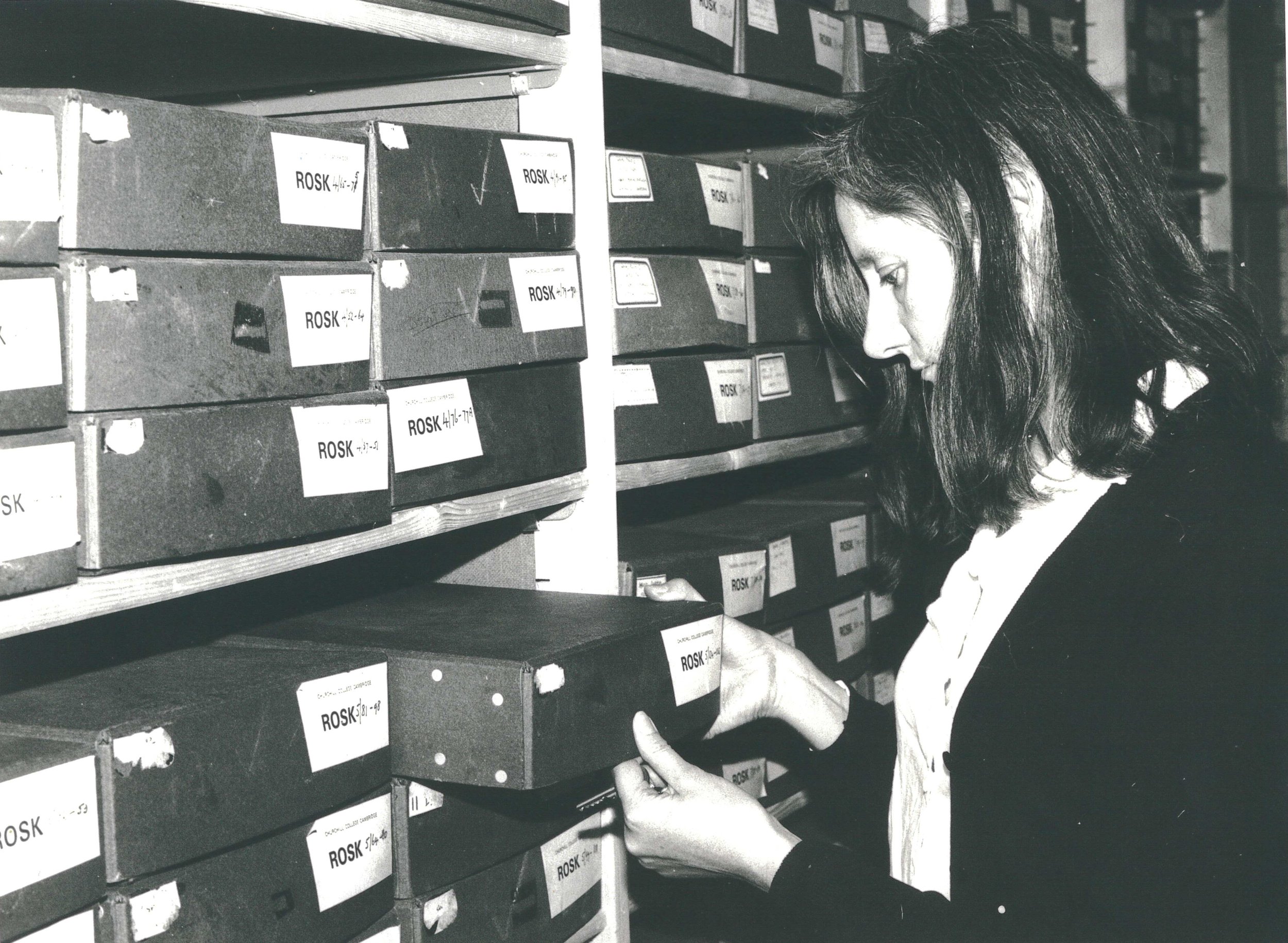
Archive Assistant (?) Pat Ackerman retrieving boxes from the Strong Room in 19XX. Source: Pat Ackerman personal collection
Sorting Room
Downstairs, the new Archives Centre hosted a sorting room - a place where collections could be stored while they were in the process of being catalogued. It was in this room that new collections were delivered, sorted, boxed, and catalogued. Archivists would then move the boxes upstairs to the main strong room.
In 2019, we renovated our sorting room and turned it into our reprographics room, so that we could provide more digital content to our readers. For those who are familiar with our free copying service - this is where the magic happens! We also gave ourselves a brand new sorting room with more shelving space to host our growing number of accessions.

A photograph of Marion Stewart, Archivist from 1978-1987, in the Sorting Roo in 1978. Source: XX
![A photograph of our Sorting Room in 1983, published in a brochure promoting the Archives. Vic Brown, the Archive Centre's first Conservator and XX [?] surrounded by archival files.
Source: CCAR/907/5](https://images.squarespace-cdn.com/content/v1/5f327a1eafa1f910a1b2baa9/d88b569d-083a-4535-9959-a996bc0b96c9/CCAR+907+5+pt+1+1983+to+1990+brochure+archivist+in+sorting+room.jpg)
A photograph of our Sorting Room in 1983, published in a brochure promoting the Archives. Vic Brown, the Archive Centre's first Conservator and XX [?] surrounded by archival files. Source: CCAR/907/5

A photograph of our Sorting Room in 1983, published in a brochure promoting the Archives in 1994. Members of staff from left to right are Kathryn Beckett (Assistant Archivist, 1992-4), Monica Halpern (Assistant Archivist, 1994-5), and Josephine Sykes (Secretary, 1991-1995). Source: CCAR/907/5

A photograph of the Sorting Room in 2019 before the refurbishment. Source: Refurbishment 2020, CCPH 5/8/4

A photograph of the old Sorting Room turned into our new Reprographics Room following a refurbishment in 2019-20. Source: Refurbishment 2020, CCPH 5/8/4
Conservation Workshop
The final part of our new building was the conservation workshop. [ADD MORE HERE]
In an interview in 2014, Vic shared what some of his work as conservationist looked like:
“With whatever collection I was working on, whichever file I was going through, when I handled them I would go through a complete file and sort through and if there were abrasions on the papers, or tears, or flimsies, or whatever, with various treatments and support I would prepare them for binding them in order of their files. A bound, cloth bound front and back board, with a spine unit, that I could letter on the catalogue number which I put on the spine and on the front cover and the papers were securely thronged and could be issued to researchers as a bound volume.”
All the talents:
The Churchill Archives Centre Team
It all begins with an idea. Maybe you want to launch a business. Maybe you want to turn a hobby into something more. Or maybe you have a creative project to share with the world. Whatever it is, the way you tell your story online can make all the difference.
A day in the life of an archivist in the 1970s
A day in the life of an Archives Assistant in the 1970s.
ADD discussion about the role of Keeper and Director
-

Michael Hoskin
LIBRARIAN AND KEEPER OF THE ARCHIVES (1969-1973)
-

Correlli 'Bill' Barnett
KEEPER OF THE ARCHIVES (1977-1995)
-

Piers Brendon
KEEPER OF THE ARCHIVES (1995-2002).
-

Allen Packwood
DIRECTOR (1995-present)

1995: The Arrival of the Churchill Papers

The Opening of the New Wing
The arrival of the Thatcher collection, coming fast upon the acquisition of other sizeable collections, took the existing Archives Centre strongroom to capacity, requiring a new building.
Sir Denis Thatcher visited the College on 19 July 2001 and formally cut the turf for the new wing of the Churchill Archives Centre. Construction commenced in August and finished in June 2002.
Designed by Cambridge architects, Thurlow, Curtis and Carnell, the building comprises four storeys of secure archival storage. It has been constructed to an extremely high specification, designed to meet the relevant British Standard and to accord with the latest guidelines from the Historical Manuscripts Commission. The New Wing provided the permanent home for the Thatcher papers, trebling the capacity of the Archives Centre.
“Politicians’ private papers offer insights which could not be gained from any other source. The material contained in the Churchill Archives is a real national asset, which I hope that generations of researchers will quarry to good effect.”
“And everything was so basic. Libraries and archives were really, really basic. No modern technology, no computerization. You were lucky if you had a golf ball typewriter. ”
After just over a decade in operation, the Archives Committee discussed the prospect of ‘computerisation’ for the first time. A year later, archivist Elizabeth Bennett put together a report in which she recommended that the Archives Centre buy a ‘micro-computer with word processing facility’. This would make it easier for the Archives Centre to generate several documents including an accessions register, guide to holdings, catalogues, and indexes.
In 1989, the Archives Centre bought three IBM computers, together with a laser printer. These new computers were installed with the latest word processing software, Word Perfect. In the late-1990s [check], the Archives Centre acquired a microfilming machine, which was used to microfilm the Churchill papers. Ten years later, we turned our sorting room into a reprographics room, so that we could digitise archive material and share this via our remote copying service.
“It was an enormous thing that stood on the floor and had six-inch square discs.”






